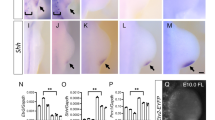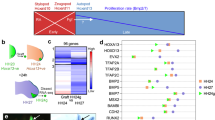Abstract
In Drosophila, the Dorsal protein establishes the embryonic dorso–ventral axis during development1. Here we show that the vertebrate homologue of Dorsal, nuclear factor-kappa B (NF-κB), is vital for the formation of the proximo–distal organizer of the developing limb bud, the apical ectodermal ridge (AER). Transcription of the NF-κB proto-oncogene c-rel is regulated, in part, during morphogenesis of the limb bud by AER-derived signals such as fibroblast growth factors. Interruption of NF-κB activity using viral-mediated delivery of an inhibitor results in a highly dysmorphic AER, reduction in overall limb size, loss of distal elements and reversal in the direction of limb outgrowth. Furthermore, inhibition of NF-κB activity in limb mesenchyme leads to a reduction in expression of Sonic hedgehog and Twist but derepresses expression of the bone morphogenetic protein-4 gene. These results are the first evidence that vertebrate NF-κB proteins act to transmit growth factor signals between the ectoderm and the underlying mesenchyme during embryonic limb formation.
This is a preview of subscription content, access via your institution
Access options
Subscribe to this journal
Receive 51 print issues and online access
$199.00 per year
only $3.90 per issue
Buy this article
- Purchase on Springer Link
- Instant access to full article PDF
Prices may be subject to local taxes which are calculated during checkout





Similar content being viewed by others
References
Nüsslein-Volhard, C., Lohs-Schardin, M., Sander, K. & Cremer, C. Adorso-ventral shift of embryonic primordia in a new maternal-effect mutant of Drosophila. Nature 283, 474–476 (1980).
Hamburger, V. & Hamilton, H. L. Aseries of normal stages in the development of the chick embryo. J.Exp. Morphol. 88, 49–92 (1951).
Summerbell, D. Aquantitative analysis of the effect of the excision of the AER from the chick limb bud. J. Embryol. Exp. Morphol. 32, 651–660 (1974).
Fallon, J. F.et al. FGF-2: apical ectodermal ridge growth signal for chick limb bud development. Science 264, 104–107 (1994).
Niswander, L., Tickle, C., Vogel, A., Booth, I. & Martin, G. R. FGF-4 replaces the apical ectodermal ridge and directs outgrowth and patterning of the limb. Cell 75, 579–587 (1993).
Vogel, A., Rodriguez, C. & Izpisua-Belmonte, J. C. Involvement of FGF-8 in initiation, outgrowth and patterning of the vertebrate limb. Development 122, 1737–1750 (1996).
Crossley, P. H., Minowada, G., MacArthur, C. A. & Martin, G. R. Roles for FGF8 in the induction, initiation and maintenance of chick limb development. Cell 84, 127–136 (1996).
Inoue, J.-i.et al. Direct association of pp40/IκBβ with rel/NF-κB transcription factors: role of ankyrin repeats in the inhibition of DNA binding activity. Proc. Natl Acad. Sci. USA 89, 4333–4337 (1992).
Brockman, J. A.et al. Coupling of a signal response domain in IκBα to multiple pathways for NF-κB activation. Mol. Cell. Biol. 15, 2809–2818 (1995).
Treanckner, E. B.-M.et al. Phosphorylation of human IκB-α on serines 32 and 36 controls IκB-α proteolysis and NF-κB activation in response to diverse stimuli. EMBO J. 14, 2876–2883 (1995).
Grumont, R. J., Richardson, I. B., Gaff, C. & Berondakis, S. Rel/NF-κB nuclear complexes that bind κB sites in the murine c-rel promoter are required for constitutive c-rel transcription in B cells. Cell Growth Differ. 4, 731–743 (1993).
Laufer, E., Nelson, C. E., Johnson, R. L., Morgan, B. A. & Tabin, C. Sonic hedgehog and FGF-4 act through a signaling cascade and feedback loop to integrate growth and patterning of the developing limb bud. Cell 79, 993–1003 (1994).
Niswander, L., Jeffrey, S., Martin, G. R. & Tickle, C. Apositive feedback loop coordinates growth and patterning in the vertebrate limb. Nature 371, 609–612 (1994).
Jiang, J., Kosman, D., Ip, Y. T. & Levine, M. The dorsal morphogen gradient regulates the mesoderm determinant twist in early Drosophila embryos. Genes Dev. 5, 1881–1891 (1991).
Pan, D., Huang, J.-D. & Courey, A. J. Functional analysis of the Drosophila twist promoter reveals a dorsal -binding ventral activator region. Genes Dev. 5, 1892–1901 (1991).
Huang, J. D., Schwyter, D. H., Shirokawa, J. M. & Courey, A. J. The interplay between multiple enhancer and silencer elements defines the pattern of decapentaplegic expression. Genes Dev. 7, 694–704 (1993).
Schwyter, D. H., Huang, J. D., Dubnicoff, T. & Courey, A. J. The decapentaplegic promoter region plays an integral role in the spatial control of transcription. Mol. Cell. Biol. 15, 3960–3968 (1995).
Gitelman, I. Twist protein in mouse embryogenesis. Dev. Biol. 189, 205–214 (1997).
Winnier, G., Blessing, M., Labosky, P. A. & Hogan, B. L. Bone morphogenetic protein-4 is required for mesoderm formation and patterning in the mouse. Genes Dev. 9, 2105–2116 (1995).
Yokouchi, Y.et al. BMP-2/-4 mediate programmed cell death in chicken limb buds. Development 122, 3725–3734 (1996).
Duprez, D.et al. Overexpression of BMP-2 and BMP-4 alters the size and shape of developing skeletal elements in the chick limb. Mech. Dev. 57, 145–157 (1996).
Saunders, J. W. Jr & Gasseling, M. T. in Epithelial-Mesenchymal Interaction(eds Fleischmayer, R. & Billingham, R. E.) 78–97 (Williams and Wilkins, Boston, (1968).
Ros, M., Lyons, G. & Fallon, J. Spatial and temporal analysis of homeobox genes expressed in chick limb buds by whole mount in situ hybridization. Prog. Clin. Biol. Res. 383A, 79–87 (1993).
Echelard, Y.et al. Sonic hedgehog, a member of a family of putative signalling molecules, is implicated in the regulation of CNS parity. Cell 75, 1417–1430 (1993).
Winnier, G. E., Hargett, L. & Hogan, B. L. The winged helix transcription factor MFH1 is required for proliferation and patterning of paraxial mesoderm in the mouse embryo. Genes Dev. 11, 926–940 (1997).
Wall, N. A. & Hogan, B. L. Expression of bone morphogenetic protein-4 (BMP-4), bone morphogenetic protein-7 (BMP-7), fibroblast growth factor-8 (FGF-8) and sonic hedgehog (SHH) during branchial arch development in the chick. Mech. Dev. 53, 383–392 (1995).
Hughes, S. H., Greenhouse, J. J., Petropoulos, C. J. & Sutrave, P. Adaptor plasmids simplify the insertion of foreign DNA into helper-independent retroviral vectors. J. Virol. 61, 3004–3012 (1987).
Morgan, B. A. & Fekete, D. M. Manipulating gene expression with replication-competent retroviruses. Methods Cell Biol. 51, 185–218 (1996).
Becker, T. C.et al. Use of recombinant adenovirus for metabolic engineering of mammalian cells. Methods Cell Biol. 43, 161–176 (1994).
Acknowledgements
We thank B. L. M. Hogan, J. Barnett, C. Wright, D. Bader, L. Rollins-Smith, and members of the Kerr laboratory for helpful discussions and critical review of this manuscript. A.McMahon for avian Shh cDNA; B. Hogan for the M-Twist and Bmp-4 cDNA; C. B. Newgard for the adenoviral shuttle and wild-type vectors; S. Hughes for RCAS-BP(A) and RCAS-AlkPhos vectors; C.McCarther for the Fgf-8 cDNA; C. Tabin for cHoxA and cHoxD cDNA series. This work was supported by an NIH grant, the American Cancer Society, and gene therapy pilot funds from the Vanderbilt Cancer Center Grant and MSKCC Support Grant. P.B.B.is a predoctoral fellow supported by an NIH training grant. L.D.K. is a recipient of an ACS Junior Faculty Research Award and a Cancer Research Institute Investigator Award.
Author information
Authors and Affiliations
Corresponding author
Supplementary information
Supplementary Information
Supplementary Information
Supplementary information
Supplementary Information
Supplementary Information
Rights and permissions
About this article
Cite this article
Bushdid, P., Brantley, D., Yull, F. et al. Inhibition of NF-κB activity results in disruption of the apical ectodermal ridge and aberrant limb morphogenesis. Nature 392, 615–618 (1998). https://doi.org/10.1038/33435
Received:
Accepted:
Issue Date:
DOI: https://doi.org/10.1038/33435
This article is cited by
-
Impact of hexavalent chromium on mammalian cell bioenergetics: phenotypic changes, molecular basis and potential relevance to chromate-induced lung cancer
BioMetals (2014)
-
Inborn errors of pyrimidine metabolism: clinical update and therapy
Journal of Inherited Metabolic Disease (2014)
-
Conditional deletion of epithelial IKKβ impairs alveolar formation through apoptosis and decreased VEGF expression during early mouse lung morphogenesis
Respiratory Research (2011)
-
Exome sequencing identifies the cause of a mendelian disorder
Nature Genetics (2010)
-
Inhibitors of NF-κB signaling: 785 and counting
Oncogene (2006)
Comments
By submitting a comment you agree to abide by our Terms and Community Guidelines. If you find something abusive or that does not comply with our terms or guidelines please flag it as inappropriate.



